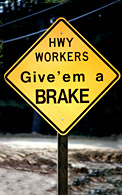Regulation and Policy

Work Zone Safety and Mobility Rule (Subpart J)
The Rule on Work Zone Safety and Mobility was published in the Federal Register (69 FR 54562) on September 9, 2004 with an effective date of October 12, 2007. The purpose of the update is to address the changing times of more traffic, more congestion, greater safety issues, and more work zones. FHWA is working on a number of implementation guidance tools to help practitioners implement the provisions of the Rule. These guidance tools and other information pertaining to the rule will be posted to the Rule section of this web site as they are developed
Temporary Traffic Control Devices Rule (Subpart K)
The Final Rule on Temporary Traffic Control Devices was published in the Federal Register (72 FR 68480) on December 5, 2007 with an effective date of December 4, 2008. This Rule supplements FHWA's regulation that governs work zone safety and mobility in highway and street work zones to include conditions for the appropriate use of, and expenditure of funds for, uniformed law enforcement officers, positive protective measures between workers and motorized traffic, and installation and maintenance of temporary traffic control devices during construction, utility, and maintenance operations. This rulemaking is in response to section 1110 of the Safe, Accountable, Flexible, Efficient Transportation Equity Act: A Legacy for Users (SAFETEA-LU).
- Frequently Asked Questions (HTML, PDF 23KB)
- Webinar on the Temporary Traffic Control Devices Rule (video recording and presentation slides)
- Work Zone Positive Protection Toolbox (PDF, 683KB) - This toolbox describes the various types of positive protection devices currently in use, as well as provides guidance on where and how each device is typically used.
- Final Rule (72 FR 68480) - Published in the Federal Register on December 5, 2007 (HTML, PDF 102KB)
- Notice of Proposed Rulemaking; extension of comment period (71 FR 75898) - Published in the Federal Register on December 19, 2006 (HTML, PDF 44KB)
- Notice of Proposed Rulemaking, Request for Comments (71 FR 64173) - Published in the Federal Register on November 1, 2006 (HTML, PDF 92KB)
Worker Visibility
On November 24, 2006 FHWA published the final rule on worker visibility, requiring the use of high-visibility safety apparel by workers who are working within the rights-of-way of Federal-aid highways.
- New 09/19/08 Recordings and Presentations from Webinar on High Visibility Garments Regulation - On September 4, 2008, the National Work Zone Safety Information Clearinghouse held a webinar on the new FHWA Worker Visibility regulation that takes effect November 24, 2008. Speakers were Hari Kalla, MUTCD Team Leader for FHWA's Office of Operations, and Janice Bradley, Technical Director of the International Safety Equipment Association.
- High-Visibility Safety Apparel in Highway Work Zones Brochure (PDF 2.1MB) - This brochure describes when and how high-visibility safety apparel should be replaced.
- Final Rule (71 FR 67792) - Published in the Federal Register on November 24, 2006. (HTML, PDF 85KB)
- Worker Visibility - Notice of Proposed Rulemaking (HTML, PDF 68KB) - Published in the Federal Register on April 24, 2006.
- Revised American National Standard for High-Visibility Safety Apparel and Headwear, ANSI/ISEA 107-2004 - On September 15 2004, the American National Standards Institute (ANSI) approved a revised edition of the standard, ANSI/ISEA 107-2004. This standard provides a uniform, authoritative guide for the design, performance specifications, and use of high-visibility and reflective apparel including vests, jackets, bib/jumpsuit coveralls, trousers and harnesses.
- Changes in High Visibility Standards (PDF 896KB) - Presentation from American Road and Transportation Builders Association 2004 National Work Zone Conference.
Manual on Uniform Traffic Control Devices
The Manual on Uniform Traffic Control Devices (MUTCD) defines the standards used by road managers nationwide to install and maintain traffic control devices on all streets and highways. The MUTCD is published by the Federal Highway Administration (FHWA) under 23 Code of Federal Regulations (CFR), Part 655, Subpart F.
New 09/9/08 Advance Construction of Federal Aid Projects
On August 26, 2008, the Federal Highway Administration issued the Final Rule on Advance Construction of Federal Aid Projects (23 CFR Part 630) (PDF 55KB). This Rule, which takes effect on September 25, 2008, aims to increase state flexibility in spending federal-aid highway funds. The Rule eliminates the requirement that states reserve federal funds for advance construction projects, some of which might not end up using federal money. That flexibility frees states to use the federal money for other projects. The advance construction procedures have been modified to comply with SAFETEA-LU. Under advance construction procedures, a state may begin projects without a guarantee of federal funds but with federal approval of the project. The state may then later apply to have the project converted to federal aid funding.
Special Experimental Project (SEP-15) to Explore Alternative and Innovative Approaches to the Overall Project Development Process
In 2004, FHWA created the Special Experimental Project (SEP-15) to identify innovative public-private partnership approaches to project delivery. SEP-15 aims to increase project management flexibility, improve efficiency and timely project implementation, and explore new revenue streams. The project also addresses environmental compliance and right-of-way acquisition. State DOT projects approved for participation in SEP-15 may be granted flexibility in meeting FHWA's traditional project approval requirements.
![]() You
will need the Adobe
Acrobat Reader to view the PDFs on this page.
You
will need the Adobe
Acrobat Reader to view the PDFs on this page.
